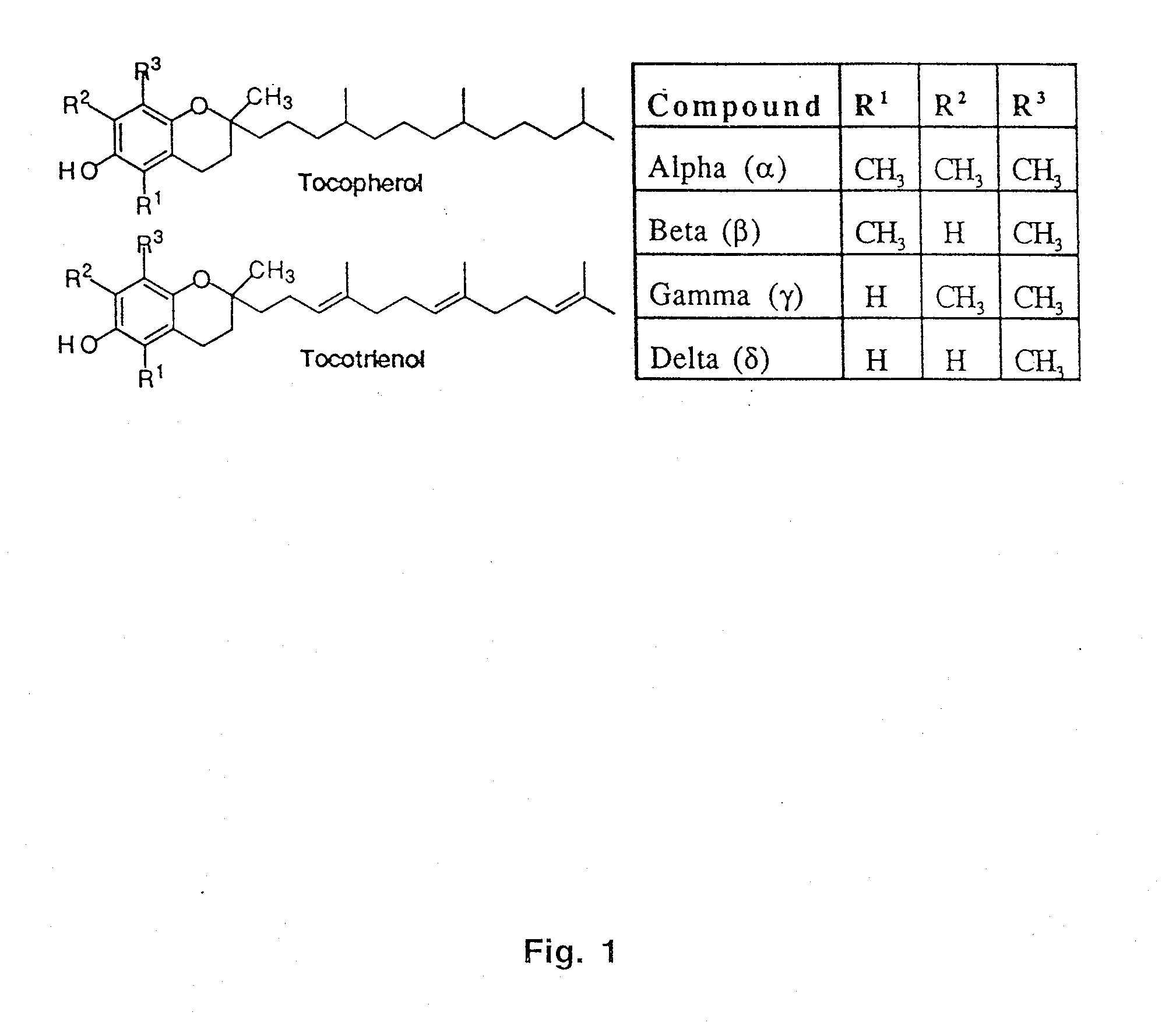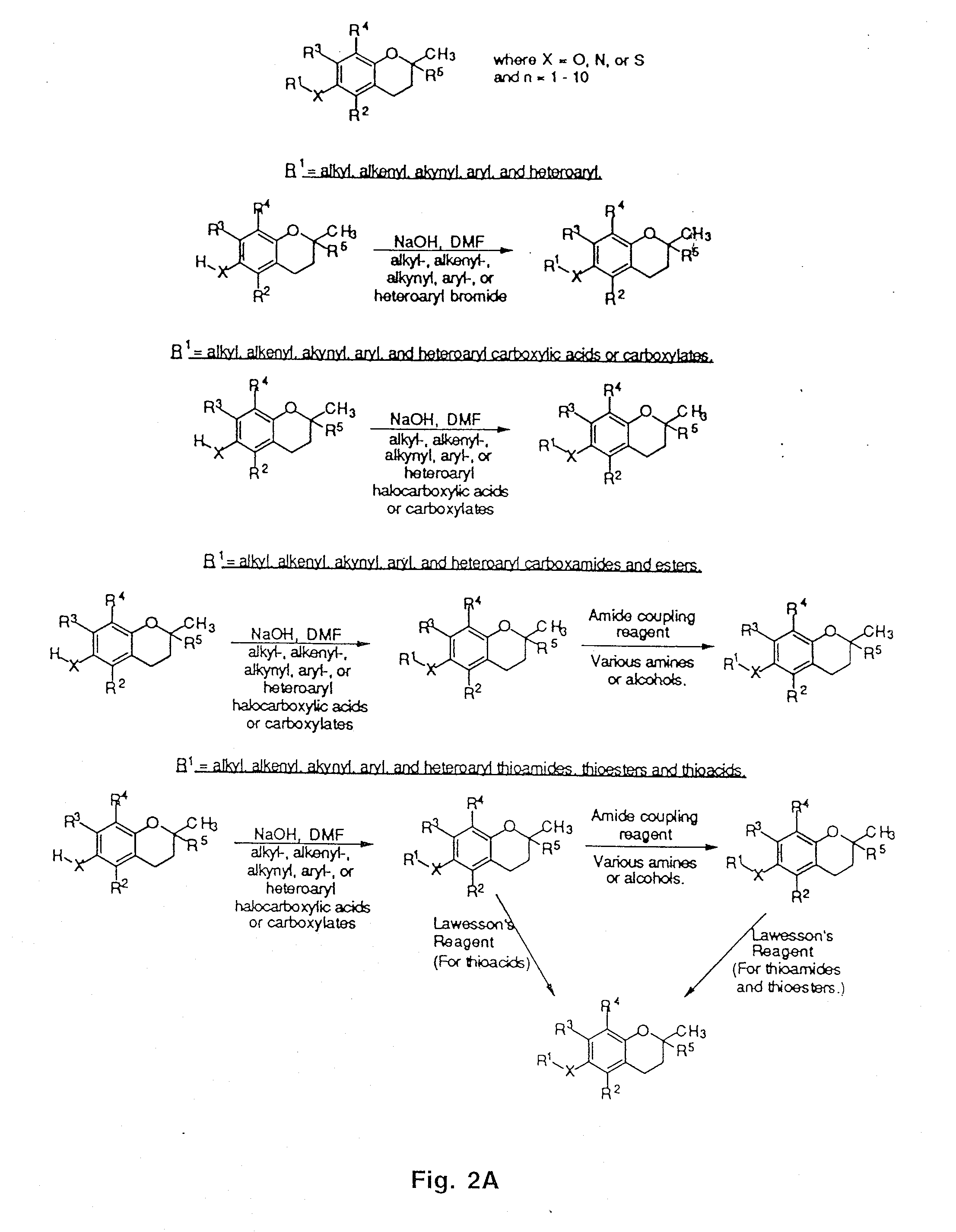Tocopherols, tocotrienols, other chroman and side chain derivatives and uses thereof
a technology of tocotrienols and chroman, which is applied in the field of organic chemistry and antiproliferative and proapoptotic compounds, can solve the problems of individual death, accumulation and potential metastasis of life-threatening cancer cells, and complex regulatory controls of pro-life (cell proliferation) and pro-death (apoptosis)
- Summary
- Abstract
- Description
- Claims
- Application Information
AI Technical Summary
Benefits of technology
Problems solved by technology
Method used
Image
Examples
example 1
Synthetic Organic Methodology
[0053]The synthesis of a variety of tocopherol, tocotrienol, and other chroman derivatives with or without derivatives of saturated phytyl or unsaturated isoprenyl side chains or analogs thereof is possible via structural modification of the chroman ring system (FIGS. 2-5) and heteroatom substitutions (N or S) for the chroman ring oxygen (FIG. 6A-6B). The structural variables R1, R2, R3, R4, R5, R7 and X illustrate the groups on the chroman group that are modified and Y represents either oxygen, or heteroatom substitutions (N or S) for the chroman ring oxygen. In naturally occurring α-, β-, γ-, δ-tocopherols and α-, β-, γ-, δ-tocotrienols, the X—R1 substituent at the six position of the chroman ring is hydroxyl; in a general structure this is represented by R7. When Y is nitrogen, it may be substituted with a structural variable R6, e.g., hydrogen or methyl.
[0054]Using alkylation chemistry, a large number of compounds containing different R1 groups can b...
example 2
Synthesis and characterization of tocopherol compounds 2,5,7,8-tetramethyl-(2R-(4R,8R,12-trimethyltridecyl)chroman-6-yloxy)acetic acid (1)
[0058]
[0059]A solution of R,R,R-α-tocopherol (0.5 g, 1.16 mmol) in N,N-dimethylformamide (20 mL) was treated with methyl bromoacetate (3.4 g, 8.3 mmol) and an excess of powdered NaOH (1.2 g, 30 mmol). The resulting yellow slurry was stirred vigorously for 24 h at room temperature. The reaction was acidified with 5 N HCl and extracted with diethyl ether (3×30 ml). The combined ether layers were washed with H2O (3×30 ml) and brine (1×30 ml), and then dried with Na2SO4. The ether solution was concentrated to a yellow oil that was purified by silica gel chromatography eluting with 19% (v / v) EtOAc and 2% acetic acid in hexanes. The resulting yellow liquid was dissolved in diethyl ether (30 ml), washed with H2O (3×20 mL) and brine (1×20 mL), and then dried with Na2SO4. The resulting solution was concentrated to a light yellow oil and dried in vacuo for ...
example 3
Synthesis of 2,5,7,8-tetramethyl-2R-(4,8,12-trimethyl-3,7,11 E:Z tridecatrien)chroman-6-yloxy)acetic acid (44)
[0157]
[0158]The starting material was 89% pure R,R,R,-alpha-tocotrienol obtained as a gift from Dr. Kai Baldenius, BASF Aktiengesellschaft, Ludwigshafen, Germany. The material was provided to Dr. Jeffrey Atkinson, Brock University, Ontario, Canada who prepared 44, also named 6-0-carboxymethyl alpha-tocotrienol or 6-0 CM-α-Toc, as a service. The starting material was subjected to column chromatography with a silica gel column (70-230 mesh, 60 A) using a step gradient of hexane:dichloromethane (10:1, 5:1, 1:1). The recovered material was pure RRR-alpha-tocotrienol as determined by mass spectrometry, 1H- and 13C-NMR.
[0159]NaH (0.270 g of a 60% dispersion in mineral oil, 6.7 mmol) was suspended in dry THF (75 mL) under an argon atmosphere at 0° C. for 10 min, at which time alpha-tocotrienol (2.00 g, 4.71 mmol) dissolved in 25 mL of dry THF was added via cannula. This mixture was...
PUM
| Property | Measurement | Unit |
|---|---|---|
| v/v | aaaaa | aaaaa |
| v/v | aaaaa | aaaaa |
| v/v | aaaaa | aaaaa |
Abstract
Description
Claims
Application Information
 Login to View More
Login to View More - R&D
- Intellectual Property
- Life Sciences
- Materials
- Tech Scout
- Unparalleled Data Quality
- Higher Quality Content
- 60% Fewer Hallucinations
Browse by: Latest US Patents, China's latest patents, Technical Efficacy Thesaurus, Application Domain, Technology Topic, Popular Technical Reports.
© 2025 PatSnap. All rights reserved.Legal|Privacy policy|Modern Slavery Act Transparency Statement|Sitemap|About US| Contact US: help@patsnap.com



